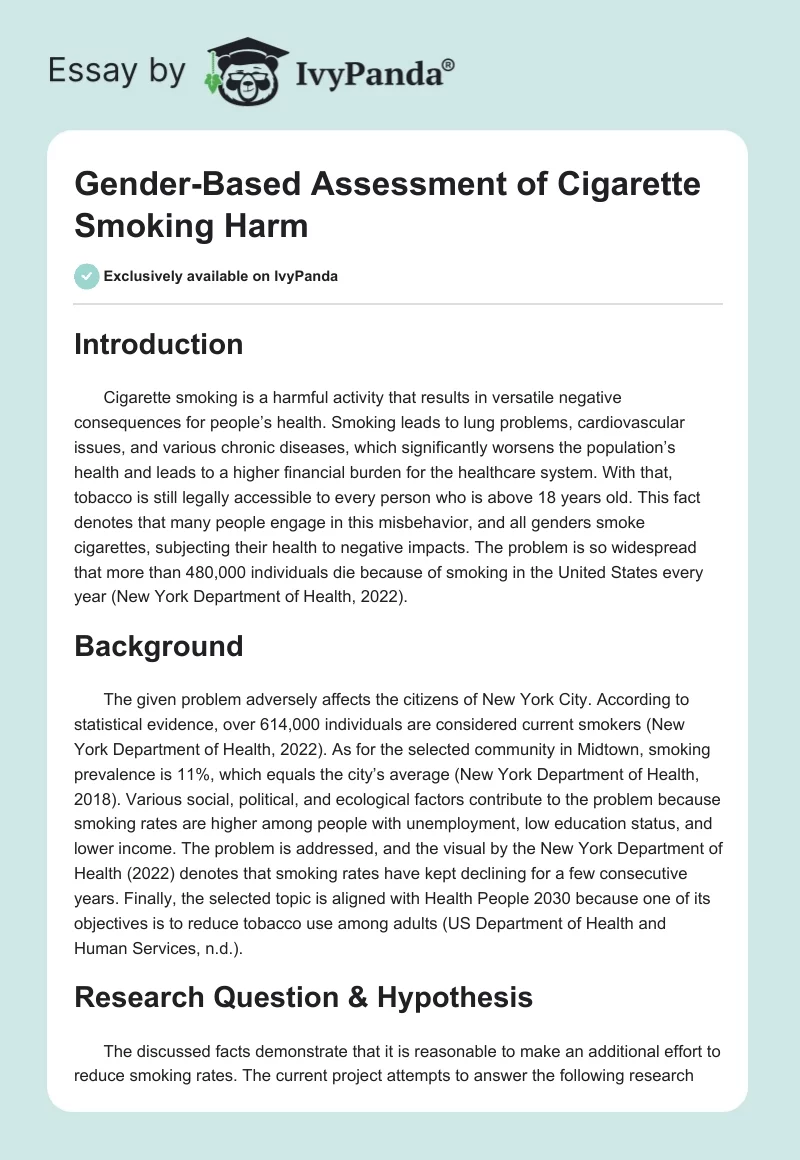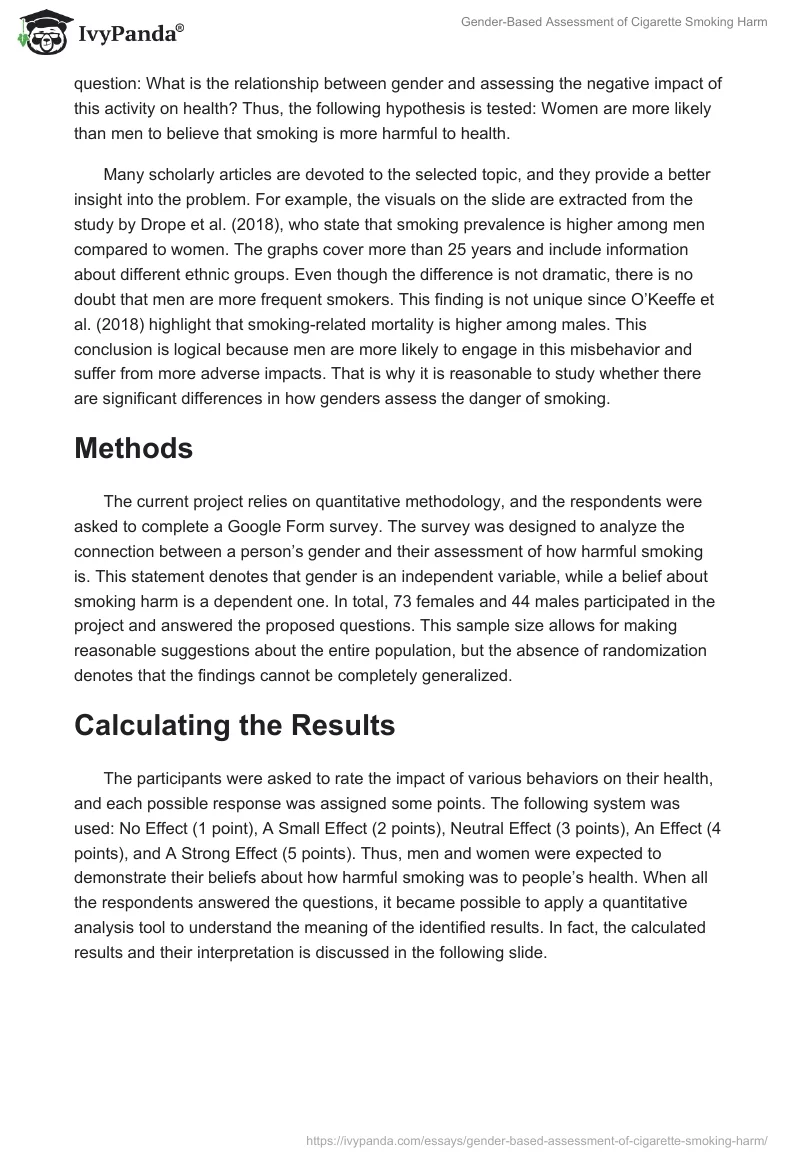Introduction
Cigarette smoking is a harmful activity that results in versatile negative consequences for people’s health. Smoking leads to lung problems, cardiovascular issues, and various chronic diseases, which significantly worsens the population’s health and leads to a higher financial burden for the healthcare system. With that, tobacco is still legally accessible to every person who is above 18 years old. This fact denotes that many people engage in this misbehavior, and all genders smoke cigarettes, subjecting their health to negative impacts. The problem is so widespread that more than 480,000 individuals die because of smoking in the United States every year (New York Department of Health, 2022).
Background
The given problem adversely affects the citizens of New York City. According to statistical evidence, over 614,000 individuals are considered current smokers (New York Department of Health, 2022). As for the selected community in Midtown, smoking prevalence is 11%, which equals the city’s average (New York Department of Health, 2018). Various social, political, and ecological factors contribute to the problem because smoking rates are higher among people with unemployment, low education status, and lower income. The problem is addressed, and the visual by the New York Department of Health (2022) denotes that smoking rates have kept declining for a few consecutive years. Finally, the selected topic is aligned with Health People 2030 because one of its objectives is to reduce tobacco use among adults (US Department of Health and Human Services, n.d.).
Research Question & Hypothesis
The discussed facts demonstrate that it is reasonable to make an additional effort to reduce smoking rates. The current project attempts to answer the following research question: What is the relationship between gender and assessing the negative impact of this activity on health? Thus, the following hypothesis is tested: Women are more likely than men to believe that smoking is more harmful to health.
Many scholarly articles are devoted to the selected topic, and they provide a better insight into the problem. For example, the visuals on the slide are extracted from the study by Drope et al. (2018), who state that smoking prevalence is higher among men compared to women. The graphs cover more than 25 years and include information about different ethnic groups. Even though the difference is not dramatic, there is no doubt that men are more frequent smokers. This finding is not unique since O’Keeffe et al. (2018) highlight that smoking-related mortality is higher among males. This conclusion is logical because men are more likely to engage in this misbehavior and suffer from more adverse impacts. That is why it is reasonable to study whether there are significant differences in how genders assess the danger of smoking.
Methods
The current project relies on quantitative methodology, and the respondents were asked to complete a Google Form survey. The survey was designed to analyze the connection between a person’s gender and their assessment of how harmful smoking is. This statement denotes that gender is an independent variable, while a belief about smoking harm is a dependent one. In total, 73 females and 44 males participated in the project and answered the proposed questions. This sample size allows for making reasonable suggestions about the entire population, but the absence of randomization denotes that the findings cannot be completely generalized.
Calculating the Results
The participants were asked to rate the impact of various behaviors on their health, and each possible response was assigned some points. The following system was used: No Effect (1 point), A Small Effect (2 points), Neutral Effect (3 points), An Effect (4 points), and A Strong Effect (5 points). Thus, men and women were expected to demonstrate their beliefs about how harmful smoking was to people’s health. When all the respondents answered the questions, it became possible to apply a quantitative analysis tool to understand the meaning of the identified results. In fact, the calculated results and their interpretation is discussed in the following slide.
Results
At first sight, attention is drawn to the fact that more men (65.9%) than women (50.7%) stipulated that smoking had a strong effect on health. However, individual responses cannot reveal the entire picture, and it is reasonable to rely on descriptive statistics. Thus, the mean value was 4.25 for males and 4.39 for females. This finding demonstrates that women consider smoking more impactful on their health compared to men, even though not a big difference exists. One can suggest that this belief makes females refrain from smoking.
Conclusion & Recommendations
Descriptive analysis has demonstrated that women tend to believe that smoking is more impactful on people’s health. The focus on the mean values supports this conclusion. One can suggest that men are more likely to smoke because they underestimate the negative impact of this activity on their health. Thus, it is necessary to make males better understand the harmful effects of smoking, which can reduce smoking prevalence within this gender group. It is possible to expand this project by finding relations between the identified information and specific health outcomes. For instance, one can focus on which gender is more subject to smoking-related lung cancer.
References
Drope, J., Liber, A. C., Cahn, Z., Stoklosa, M., Kennedy, R., Douglas, C. E., Henson, R., & Drope, J. (2018). Who’s still smoking? Disparities in adult cigarette smoking prevalence in the United States. CA: A Cancer Journal for Clinicians, 68(2), 106-115. Web.
New York Department of Health. (2018). Midtown: Community health profiles 2018 [PDF document]. Web.
New York Department of Health. (2022). Cigarette smoking [PDF document]. Web.
O’Keeffe, L. M., Taylor, G., Huxley, R. R., Mitchell, P., Woodward, M., & Peters, S. A. (2018). Smoking as a risk factor for lung cancer in women and men: A systematic review and meta-analysis. BMJ Open, 8(10), 1-12. Web.
US Department of Health and Human Services. (n.d.). Healthy People 2030. Web.


